The Mechanical Properties and Damage Evolution of UHPC Reinforced with Glass Fibers and High-Performance Polypropylene Fibers
Abstract
1. Introduction
2. Experimental Study
2.1. Materials
2.2. Experimental Investigation
3. Numerical Study
3.1. Yield Function and Flow Rule
3.2. The Equivalent Plastic Strain and the Effective Stress
3.3. Constitutive Relation and Damage Parameter
4. Results and Discussions
4.1. Compressive Properties
4.1.1. Comparison of Test and Numerical Values
4.1.2. Mixing Effect of Fibers
4.2. Tensile Properties
4.2.1. Comparison of Test and Numerical Values
4.2.2. Mixing Effect of Fibers
4.3. Bending Properties
4.3.1. Comparison of Test and Numerical Values
4.3.2. Mixing Effect of Fibers
5. Conclusions
- The mechanical properties of GF-UHPC and HPP-UHPC with 2.0% fiber content were better in the research. With the increase of fiber content, the amplification of mechanical properties of HPP-UHPC was slightly higher than that of GF-UHPC. Moreover, it should be pointed out that the mechanical properties of UHPC did not necessarily increase with the growing fiber content in the research;
- Glass fibers had a more efficient reinforcement effect than HPP fibers. With the same fiber volume content, the cubic compressive strength, the tensile strength and the flexural strength of GF-UHPC were about 20%, 30% and 20–50% higher than those of HPP-UHPC, as glass fibers had higher elastic modulus and stronger inhibition of microcracks;
- The toughening effect of HPP fibers was better than that of glass fibers. With the same fiber volume content, the bending toughness indexes I5, I10 and I20 of HPP-UHPC were about 1.2 times, 2.0 times, and 3.8 times of those of GF-UHPC, as long HPP fibers could further play a role in the connection of macrocracks after initial cracking;
- The strength indexes of G/H-UHPC increased with the increase of glass fiber content, and the toughness indexes increased with an increase of HPP fiber content. The mixing effects of the tensile strength, the flexural strength, the bending toughness indexes I5, I10 and I20 at high glass fibers content were positive, as more “region I” (Figure 7) exiting in G/H-UHPC with low glass fibers amount and it was difficult to obtain a positive effect like “1 + 1 > 2”;
- The material degradation area of the CDP model of UHPC axial compression was approximately the “X” shape, which was consistent with the pyramid-shaped or hourglass-shaped failure bodies formed in the test;
- According to the fitting formulas summarized in reference [45], the peak compressive strain, the elastic modulus and the dimensionless material constant A could be calculated from the cubic compressive strength of UHPC and used in numerical simulation. The simulation results were in good agreement with the experimental results, which proves that the exponential constitutive relation could be applied to finite element analysis of UHPC without tensile strain hardening, and the model establishment method was reliable.
Author Contributions
Funding
Institutional Review Board Statement
Informed Consent Statement
Data Availability Statement
Conflicts of Interest
References
- Ren, Q.; Zeng, Z.; Jiang, Z.; Li, H. Functionalization of renewable bamboo charcoal to improve indoor environment quality in a sustainable way. J. Clean. Prod. 2019, 246, 119028. [Google Scholar] [CrossRef]
- Lai, J.; Sun, W. Dynamic Mechanical Behaviour of Ultra-high Performance Fiber Reinforced Concretes. J. Wuhan Univ. Technol. 2008, 23, 938–945. [Google Scholar] [CrossRef]
- Lai, J.; YIN, X.; Li, H.; Zhou, J.; Kang, N. Anti-Penetration and Explosion Performance of Ultra-High Performance Concrete Based on the Principle of Functional Gradient. J. Chin. Ceram. Soc. 2020, 48, 1188–1200. [Google Scholar]
- Habel, K.; Viviani, M.; Denarié, E.; Brühwiler, E. Development of the mechanical properties of an Ultra-High Performance Fiber Reinforced Concrete (UHPFRC). Cem. Concr. Res. 2006, 36, 1362–1370. [Google Scholar] [CrossRef]
- Liu, K.; Yu, R.; Shui, Z.; Li, X.; Guo, C.; Yu, B.; Wu, S. Optimization of autogenous shrinkage and microstructure for Ultra-High Performance Concrete (UHPC) based on appropriate application of porous pumice. Constr. Build. Mater. 2019, 214, 369–381. [Google Scholar] [CrossRef]
- He, B.; Zhu, X.; Ren, Q.; Jiang, Z. Effects of fibers on flexural strength of ultra-high-performance concrete subjected to cryogenic attack. Constr. Build. Mater. 2020, 265, 120323. [Google Scholar] [CrossRef]
- Peyvandi, A.; Sbia, L.A.; Soroushian, P.; Sobolev, K. Effect of the cementitious paste density on the performance efficiency of carbon nanofiber in concrete nanocomposite. Constr. Build. Mater. 2013, 48, 265–269. [Google Scholar] [CrossRef]
- Zhao, Y.; Lian, H.; Jin, J. A new model of steel concrete composite ultra high performance concrete (UHPC / UHPFRC) Part 4: Engineering and product application, value, potential and sustainable development. China Concr. 2014, 55, 48–64. [Google Scholar]
- Meng, W.; Khayat, K.H. Effect of graphite nanoplatelets and carbon nanofibers on rheology, hydration, shrinkage, mechanical properties, and microstructure of UHPC. Cem. Concrete Res. 2018, 105, 64–71. [Google Scholar] [CrossRef]
- Rasul, M.; Ahmad, S.; Adekunle, S.K.; Maslehuddin, M.; Syed, I.A. Evaluation of the Effect of Exposure Duration and Fiber Content on the Mechanical Properties of Polypropylene Fiber-Reinforced UHPC Exposed to Sustained Elevated Temperature. J. Test. Eval. 2020, 48, 4355–4369. [Google Scholar] [CrossRef]
- Yu, J.; Yao, J.; Lin, X.; Li, H.; Lam, J.Y.K.; Leung, C.K.Y.; Sham, I.M.L.; Shih, K. Tensile performance of sustainable Strain-Hardening Cementitious Composites with hybrid PVA and recycled PET fibers. Cem. Concr. Res. 2018, 107, 110–123. [Google Scholar] [CrossRef]
- Mosavinejad, S.; Langaroudi, M.; Barandoust, J.; Ghanizadeh, A. Electrical and microstructural analysis of UHPC containing short PVA fibers. Constr. Build. Mater. 2020, 235, 117448. [Google Scholar] [CrossRef]
- Holubova, B. Corrosion of glass fibres in ultra high performance concrete and normal strength concrete. Ceram. Silik. 2017, 61, 1–9. [Google Scholar] [CrossRef]
- Christ, R.; Pacheco, F.; Ehrenbring, H.; Quinino, U.; Tutikian, B. Study of mechanical behavior of ultra—high-performance concrete (UHPC) reinforced with hybrid fibers and with reduced cement consumption. Rev. Ing. Constr. 2019, 34, 159. [Google Scholar] [CrossRef]
- Dyy, A.; Hks, A.; Phrb, B.; Rf, C.; Sk, A. Enhancing the tensile performance of ultra-high-performance concrete through strategic use of novel half-hooked steel fibers. J. Mater. Res. Technol. 2020, 9, 2914–2925. [Google Scholar]
- Sorelli, L.G.; Meda, A.; Plizzari, G.A. Bending and Uniaxial Tensile Tests on Concrete Reinforced with Hybrid Steel Fibers. J. Mater. Civil Eng. 2005, 17, 519–527. [Google Scholar] [CrossRef]
- Park, S.H.; Dong, J.K.; Ryu, G.S.; Koh, K.T. Tensile behavior of Ultra High Performance Hybrid Fiber Reinforced Concrete. Cem. Concr. Compos. 2012, 34, 172–184. [Google Scholar] [CrossRef]
- Wu, Y.; Jie, L.; Wu, K. Mechanical properties of hybrid fiber-reinforced concrete at low fiber volume fraction. Cem. Concr. Res. 2003, 33, 27–30. [Google Scholar]
- Guodong, X.; Hannant, D.J. Flexural behaviour of combined polypropylene network and glass fibre reinforced cement. Cem. Concr. Compos. 1992, 14, 51–61. [Google Scholar]
- Kakemi, M.; Hannant, D.J. Mathematical model for tensile behaviour of hybrid continuous fibre cement composites. Composites 1995, 26, 637–643. [Google Scholar] [CrossRef]
- Yan, P.; Chen, B.; Afgan, S.; Haque, M.A.; Wu, M.; Han, J. Experimental research on ductility enhancement of ultra-high performance concrete incorporation with basalt fibre, polypropylene fibre and glass fibre. Constr. Build. Mater. 2021, 279, 122489. [Google Scholar] [CrossRef]
- Pourjahanshahi, A.; Madani, H. Chloride diffusivity and mechanical performance of UHPC with hybrid fibers under heat treatment regime. Mater. Today Commun. 2021, 26, 102146. [Google Scholar] [CrossRef]
- Rigaud, S.; Chanvillard, G.; Chen, J. Characterization of Bending and Tensile Behavior of Ultra-High Performance Concrete Containing Glass Fibers. In High Performance Fiber Reinforced Cement Composites 6; Parra-Montesinos, G.J., Reinhardt, H.W., Naaman, A.E., Eds.; CRC Press: Boca Raton, FL, USA, 2012; Volume 2, pp. 373–380. [Google Scholar]
- Yao, Z.; Li, X.; Wu, T.; Yang, L.; Liu, X. Hybrid-Fiber-Reinforced Concrete Used in Frozen Shaft Lining Structure in Coal Mines. Materials 2019, 12, 3988. [Google Scholar] [CrossRef] [PubMed]
- Behfarnia, K.; Behravan, A. Application of high performance polypropylene fibers in concrete lining of water tunnels. Mater. Des. 2014, 55, 274–279. [Google Scholar] [CrossRef]
- Haddad, R.H.; Shannag, M.J.; Hamad, R.J. Repair of heat-damaged reinforced concrete T-beams using FRC jackets. Mag. Concr. Res. 2007, 59, 223–231. [Google Scholar] [CrossRef]
- Bahij, S.; Adekunle, S.K.; Al-Osta, M.; Ahmad, S.; Al-Dulaijan, S.U.; Rahman, M.K. Numerical investigation of the shear behavior of reinforced ultra-high-performance concrete beams. Struct. Concr. J. Fib 2018, 19, 305–317. [Google Scholar] [CrossRef]
- Zhang, K.; Ni, T.; Sarego, G.; Zaccariotto, M.; Galvanetto, U. Experimental and numerical fracture analysis of the plain and polyvinyl alcohol fiber-reinforced ultra-high-performance concrete structures. Theor. Appl. Fract. Mech. 2020, 108, 102566. [Google Scholar] [CrossRef]
- Chen, L.; Graybeal, B.A. Modeling Structural Performance of Second-Generation Ultrahigh-Performance Concrete Pi-Girders. J. Bridge Eng. 2012, 17, 634–643. [Google Scholar] [CrossRef]
- Shafieifar, M.; Farzad, M.; Azizinamini, A. Experimental and numerical study on mechanical properties of Ultra High Performance Concrete (UHPC). Constr. Build. Mater. 2017, 156, 402–411. [Google Scholar] [CrossRef]
- Meng, W.; Khayat, K.H. Experimental and Numerical Studies on Flexural Behavior of Ultra-High-Performance Concrete Panels Reinforced with Embedded Glass Fiber-Reinforced Polymer Grids. Transp. Res. Rec. J. Transp. Res. Board 2016, 2592, 38–44. [Google Scholar] [CrossRef]
- Zhu, Y.; Zhang, Y.; Li, X.; Chen, G. Finite element model to predict structural response of predamaged RC beams reinforced by toughness-improved UHPC under unloading status. Eng. Struct. 2021, 235, 112019. [Google Scholar] [CrossRef]
- Andreasen, A.H.M. Ueber die Beziehung zwischen Kornabstufung und Zwischenraum in Produkten aus losen Körnern (mit einigen Experimenten). Kolloid-Zeitschrift 1930, 50, 217–228. [Google Scholar] [CrossRef]
- Yu, J.; Zhang, B.; Chen, W.; He, J. Experimental and multi-scale numerical investigation of ultra-high performance fiber reinforced concrete (UHPFRC) with different coarse aggregate content and fiber volume fraction. Constr. Build. Mater. 2020, 260, 120444. [Google Scholar] [CrossRef]
- BS EN 12390-3: 2009. Testing Hardened Concrete—Part 3: Compressive Strength of Test Specimens; British Standards Institution: London, UK, 2009. [Google Scholar]
- T/CBMF 37-2018. Fundamental Characteristics and Test Methods of Ultra-High Performance Concrete; China Building Material Council: Beijing, China, 2018. [Google Scholar]
- ASTM C1018-97. Standard Test Method for Flexural Toughness and First-Crack Strength of Fiber Reinforced Concrete (Using Beam with Third-Point Loading); American Society for Testing and Materials International: West Conshohocken, PA, USA, 1997. [Google Scholar]
- Lubliner, J.; Oliver, J.; Oller, S.; Oñate, E. A plastic-damage model for concrete. Int. J. Solids Struct. 1989, 25, 299–326. [Google Scholar] [CrossRef]
- Lee, J.; Fenves, G.L. Plastic-Damage Model for Cyclic Loading of Concrete Structures. J. Eng. Mech. 1998, 124, 892–900. [Google Scholar] [CrossRef]
- Zhong, T.; Wang, Z.B.; Yu, Q. Finite element modelling of concrete-filled steel stub columns under axial compression. J. Construct. Steel Res. 2013, 89, 121–131. [Google Scholar]
- Seow, P.E.C.; Swaddiwudhipong, S. Failure Surface for Concrete under Multiaxial Load—a Unified Approach. J. Mater. Civil Eng. 2005, 17, 219–228. [Google Scholar] [CrossRef]
- Lee, S.H.; Abolmaali, A.; Shin, K.J.; Lee, H.D. ABAQUS modeling for post-tensioned concrete beams. J. Build. Eng. 2020, 30, 101273. [Google Scholar] [CrossRef]
- Yu, T.; Teng, J.G.; Wong, Y.L.; Dong, S.L. Finite element modeling of confined concrete-I: Drucker–Prager type plasticity model. Eng. Struct. 2010, 32, 665–679. [Google Scholar] [CrossRef]
- Wu, Y. Study of the Reactive Powder Concrete (RPC) about Compressive Stress-Strain Curve. Master’s Thesis, Guangzhou University, Guangzhou, China, 2012. [Google Scholar]
- Guo, X.; Kang, J.; Zhu, J. Constitutive relationship of ultrahigh performance concrete under uni-axial compression. J. Southeast Univ. 2017, 47, 170–177. [Google Scholar]
- Jiang, J.; Lu, X. Finite Element Analysis of Concrete Structures; Tsinghua University Press: Beijing, China, 2013; pp. 47–49. [Google Scholar]
- Wang, C.; Wu, K. Research on the Hybrid Effect of Different Geometrical Size Hybrid Fiber Reinforced Concrete. J. Build. Mater. 2005, 8, 250–255. [Google Scholar]

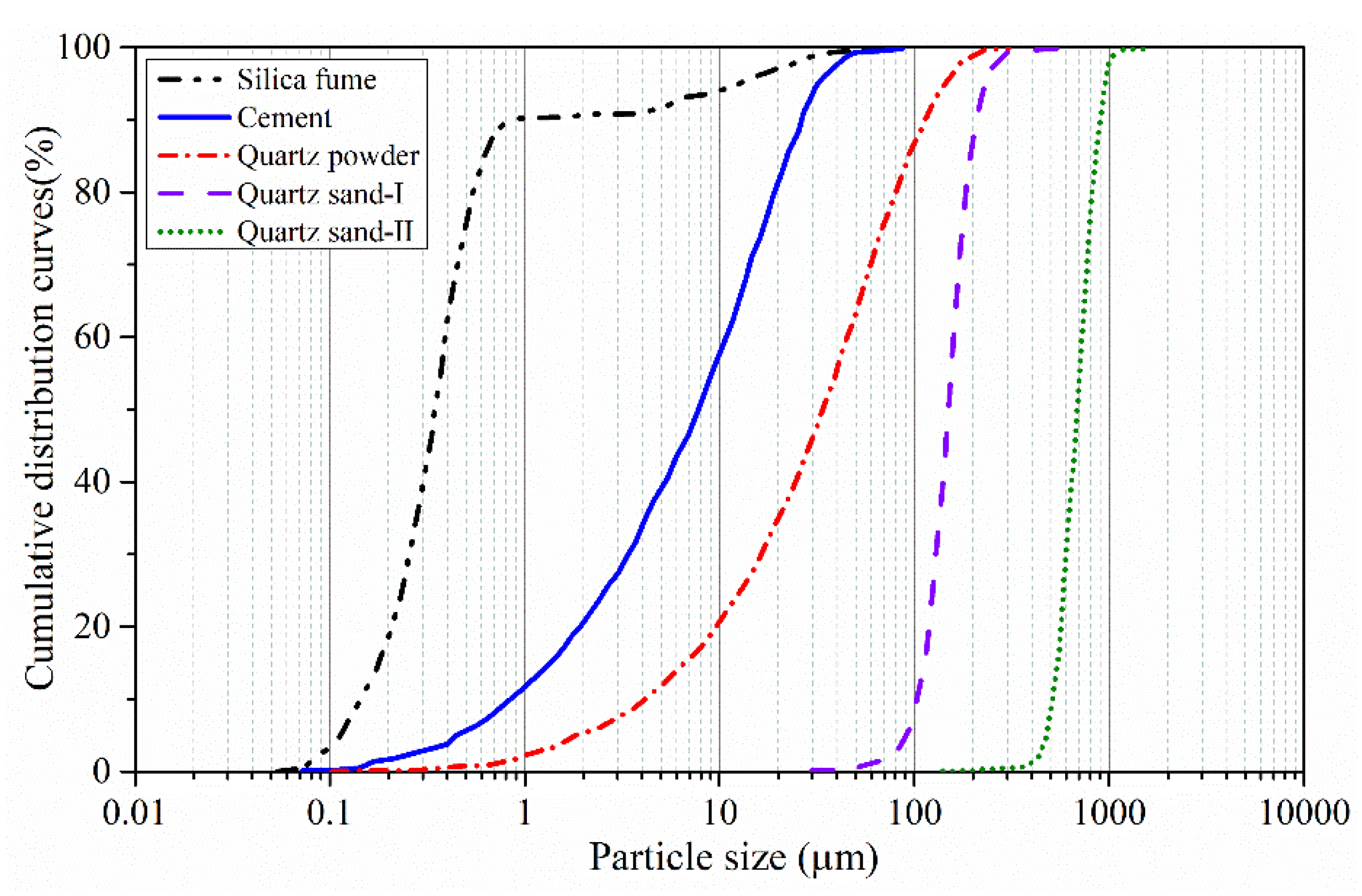
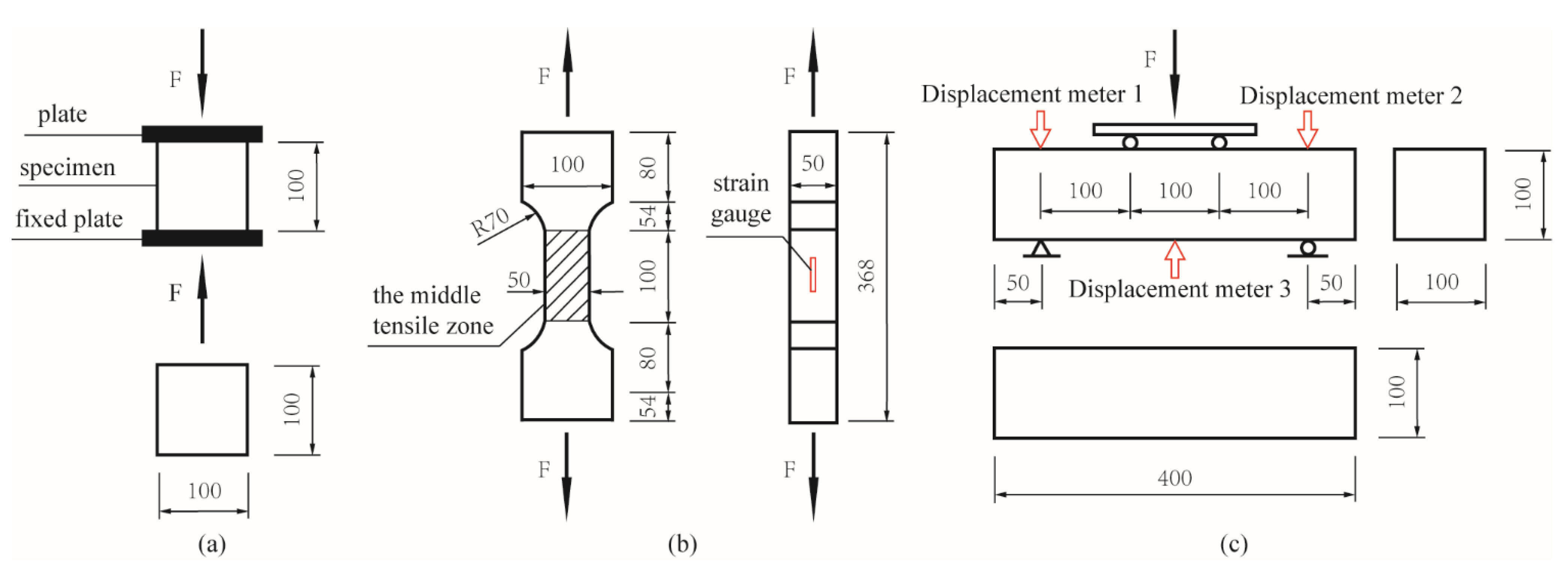
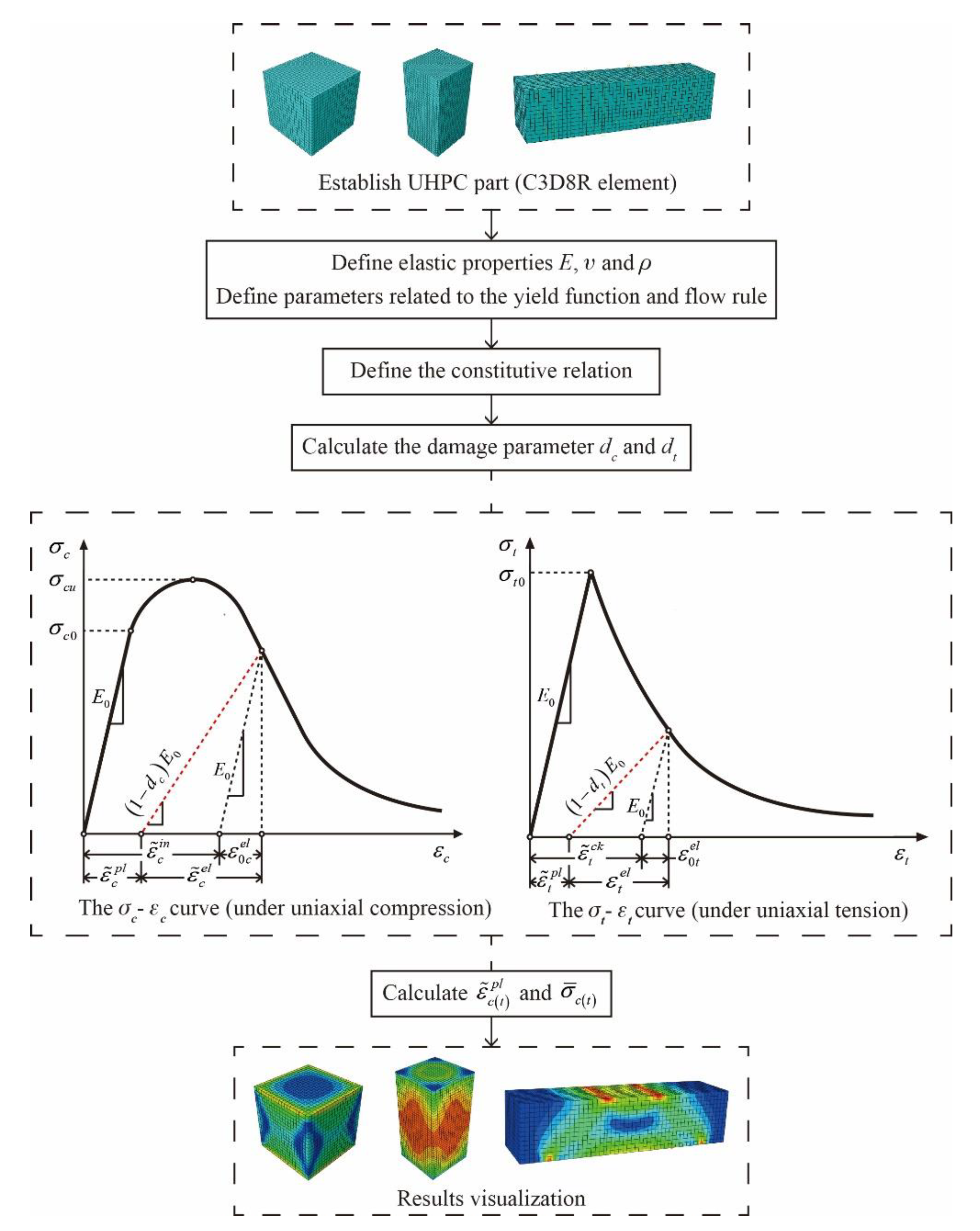

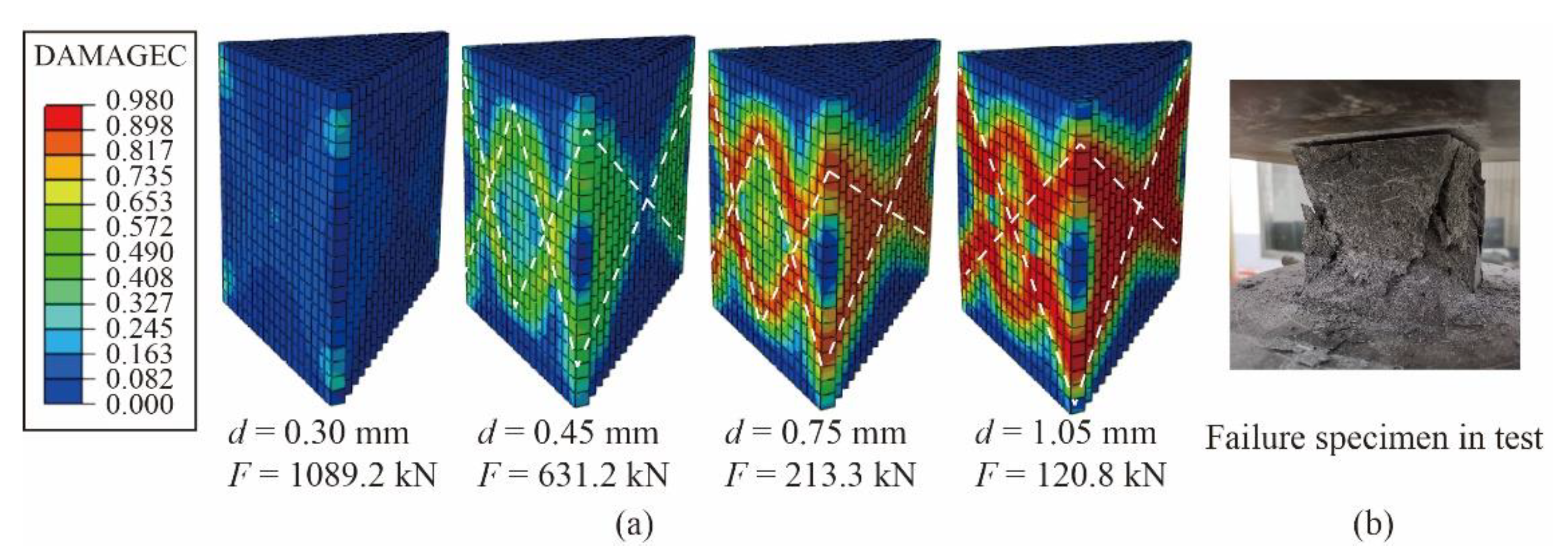
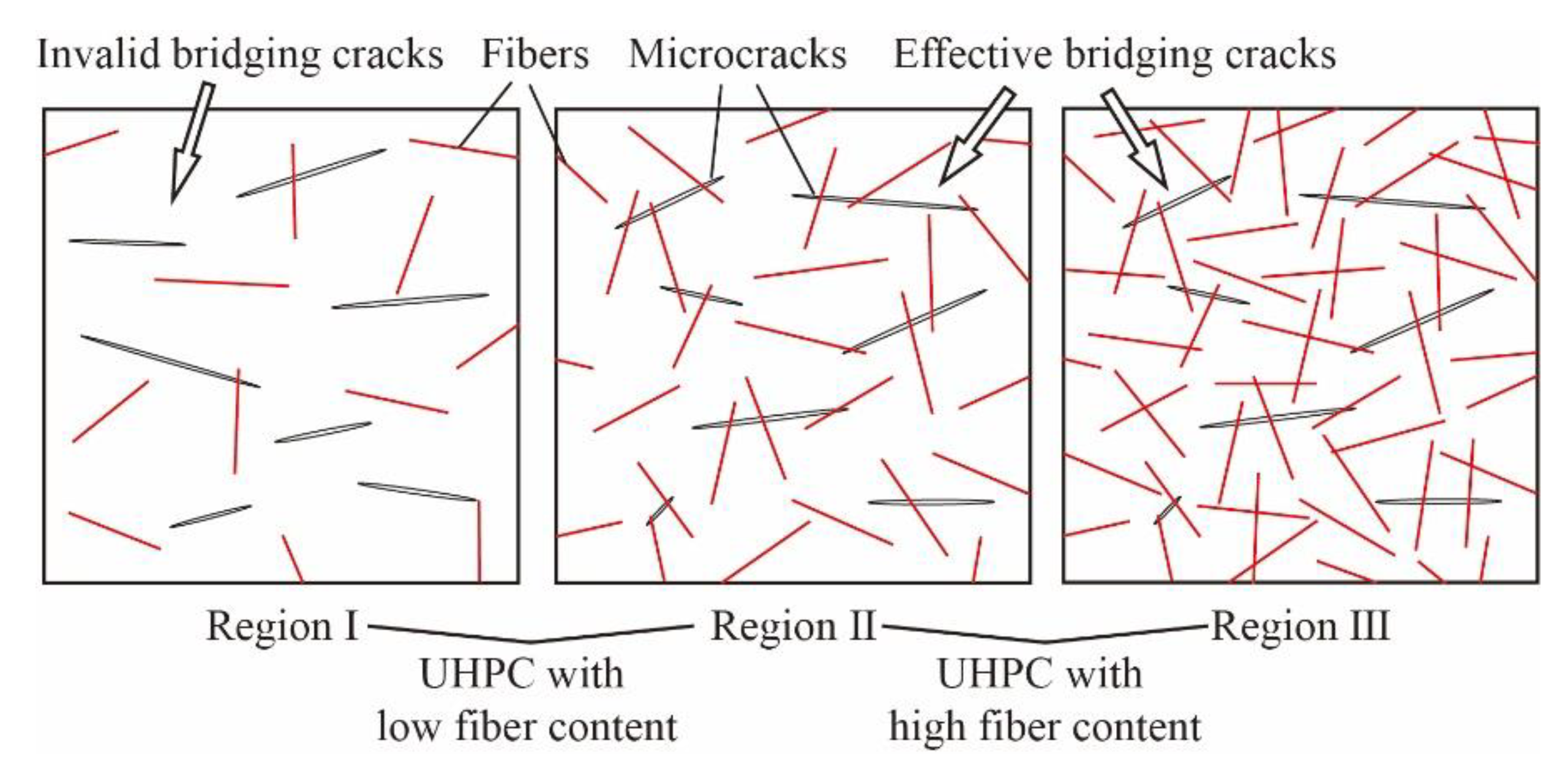


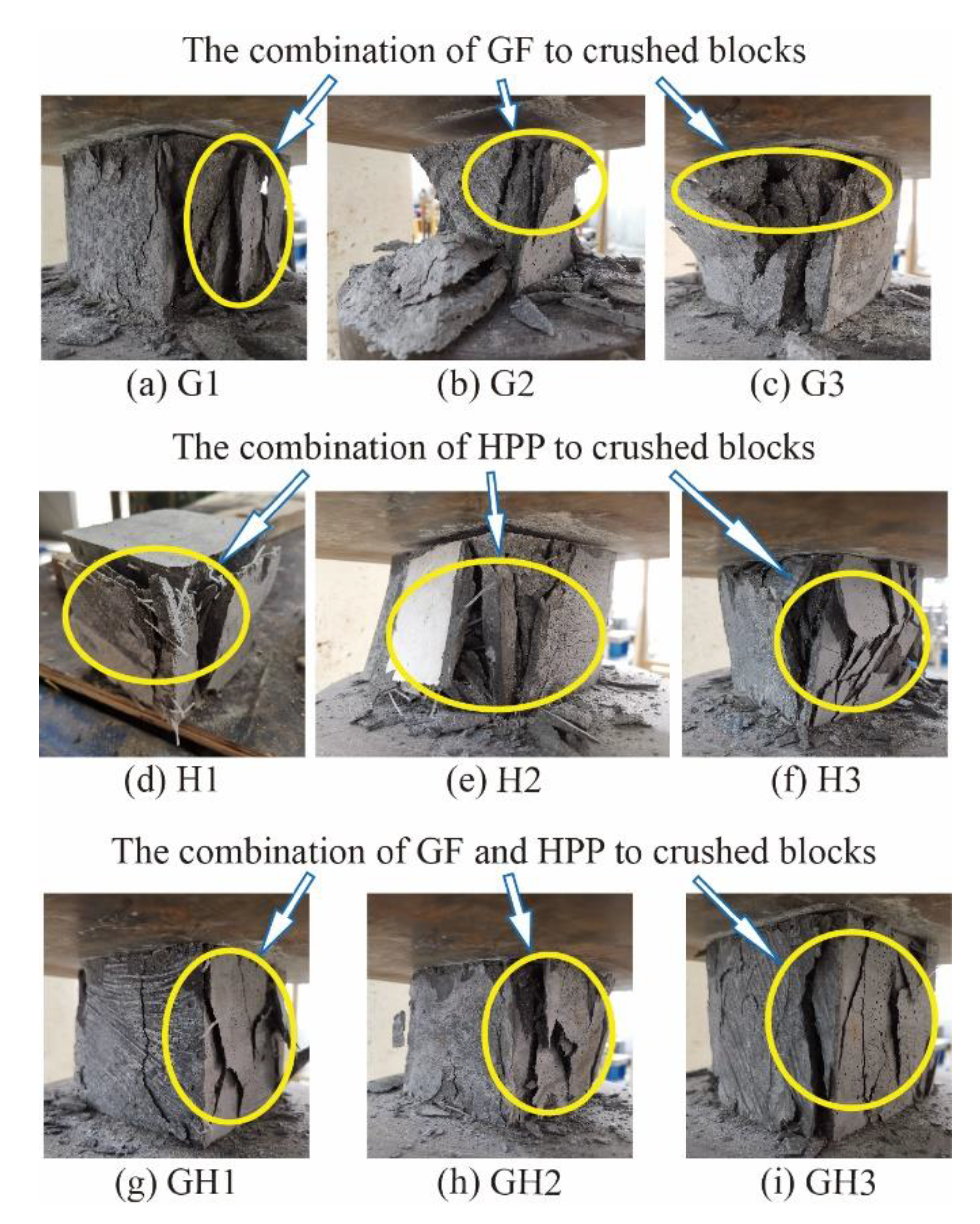

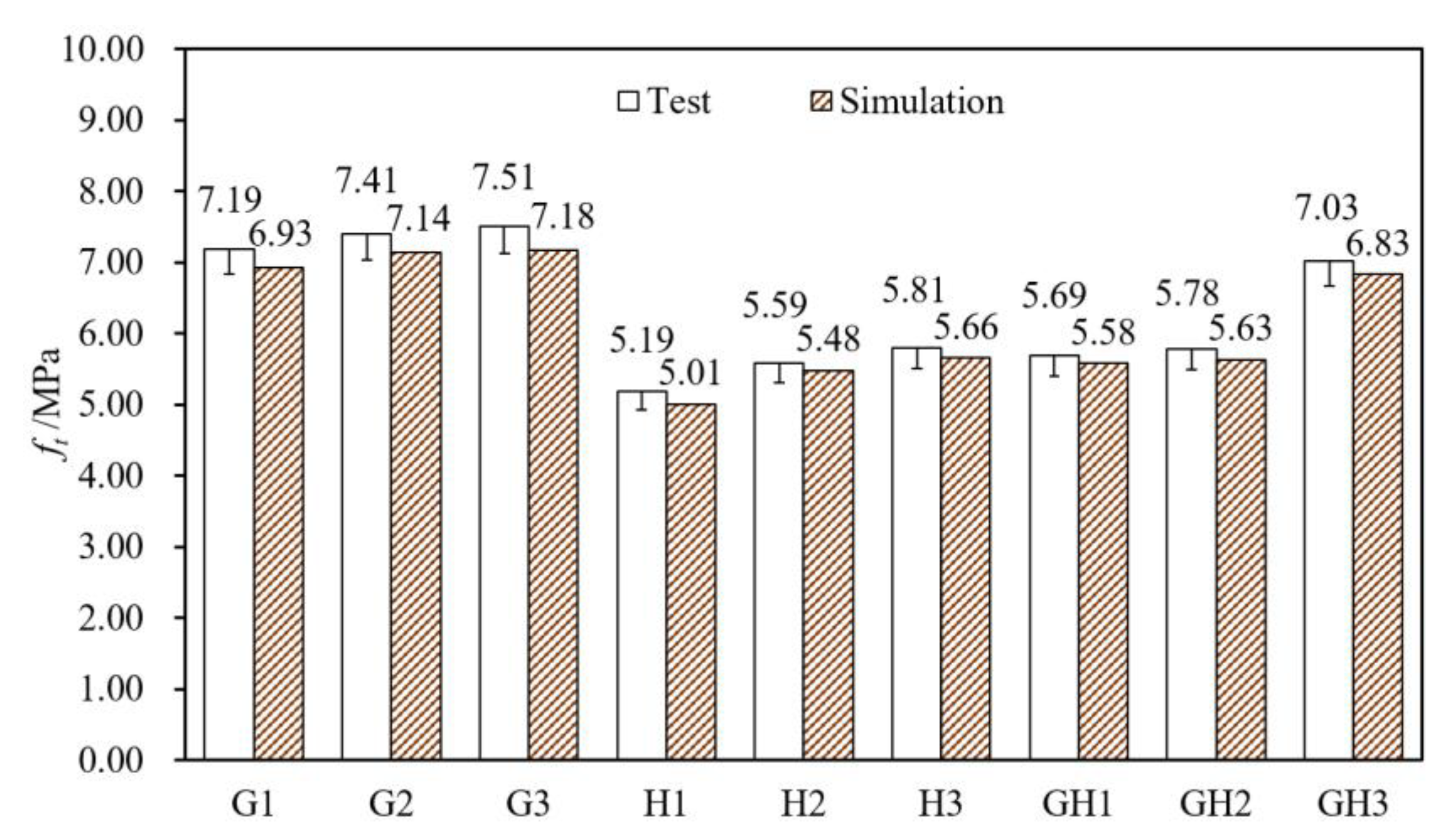
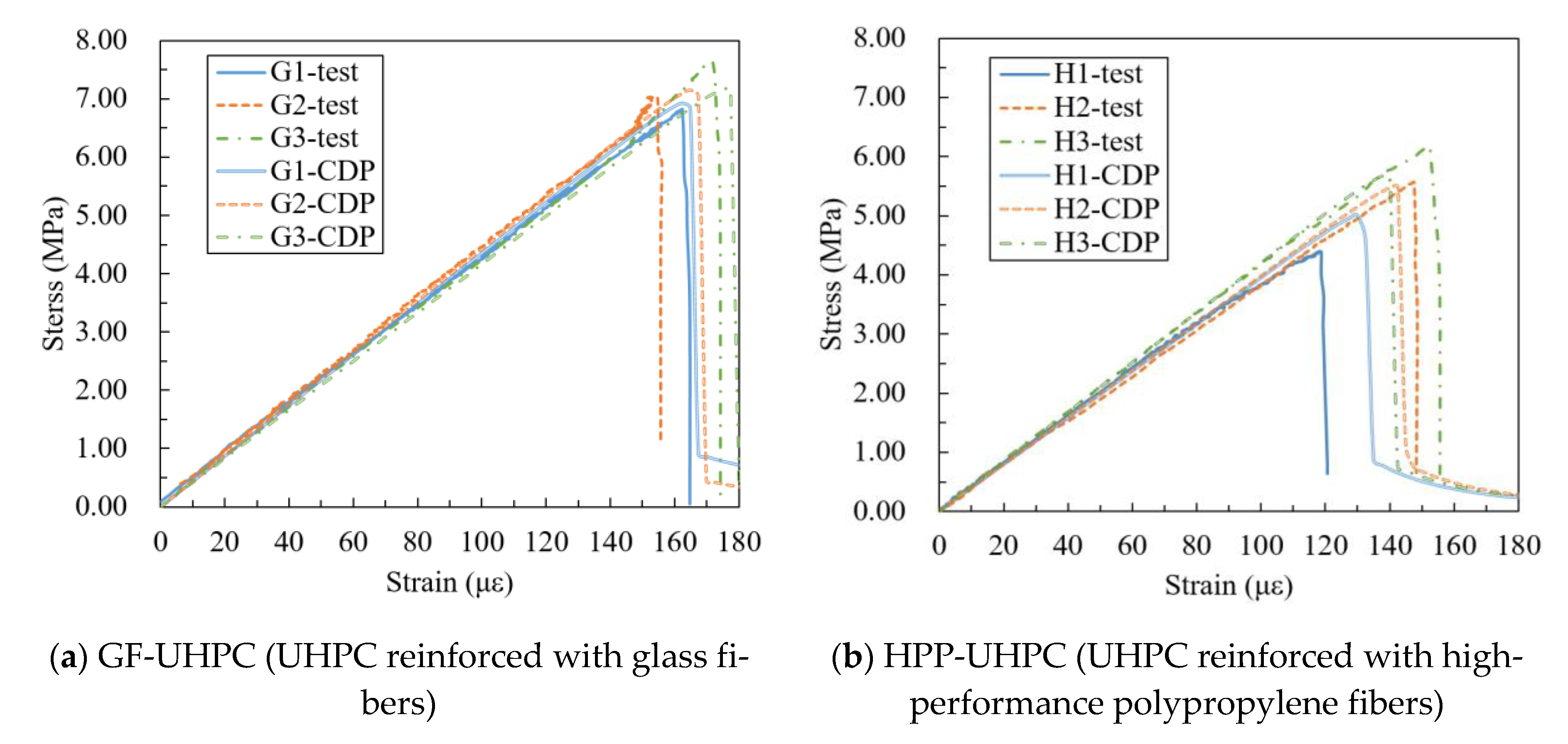
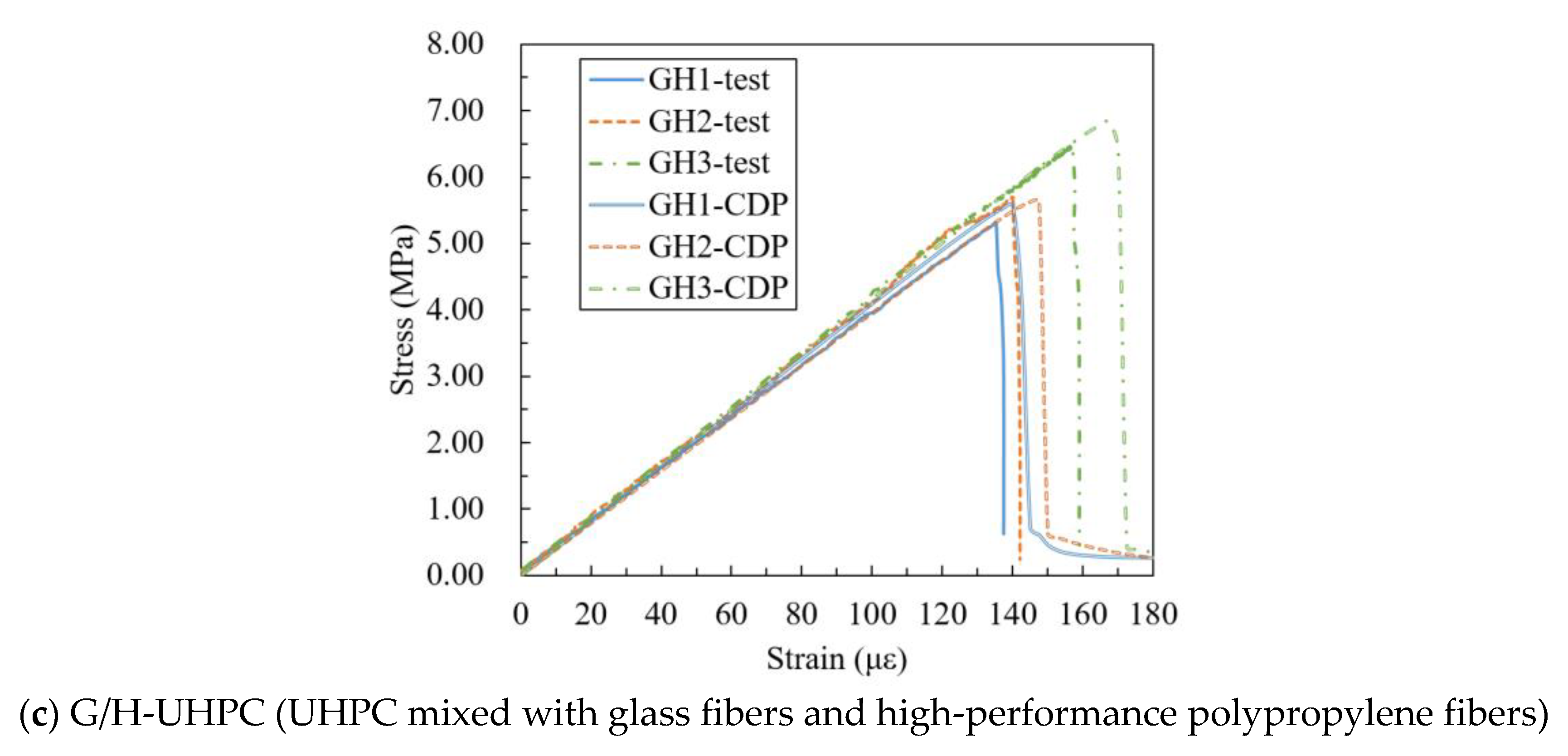
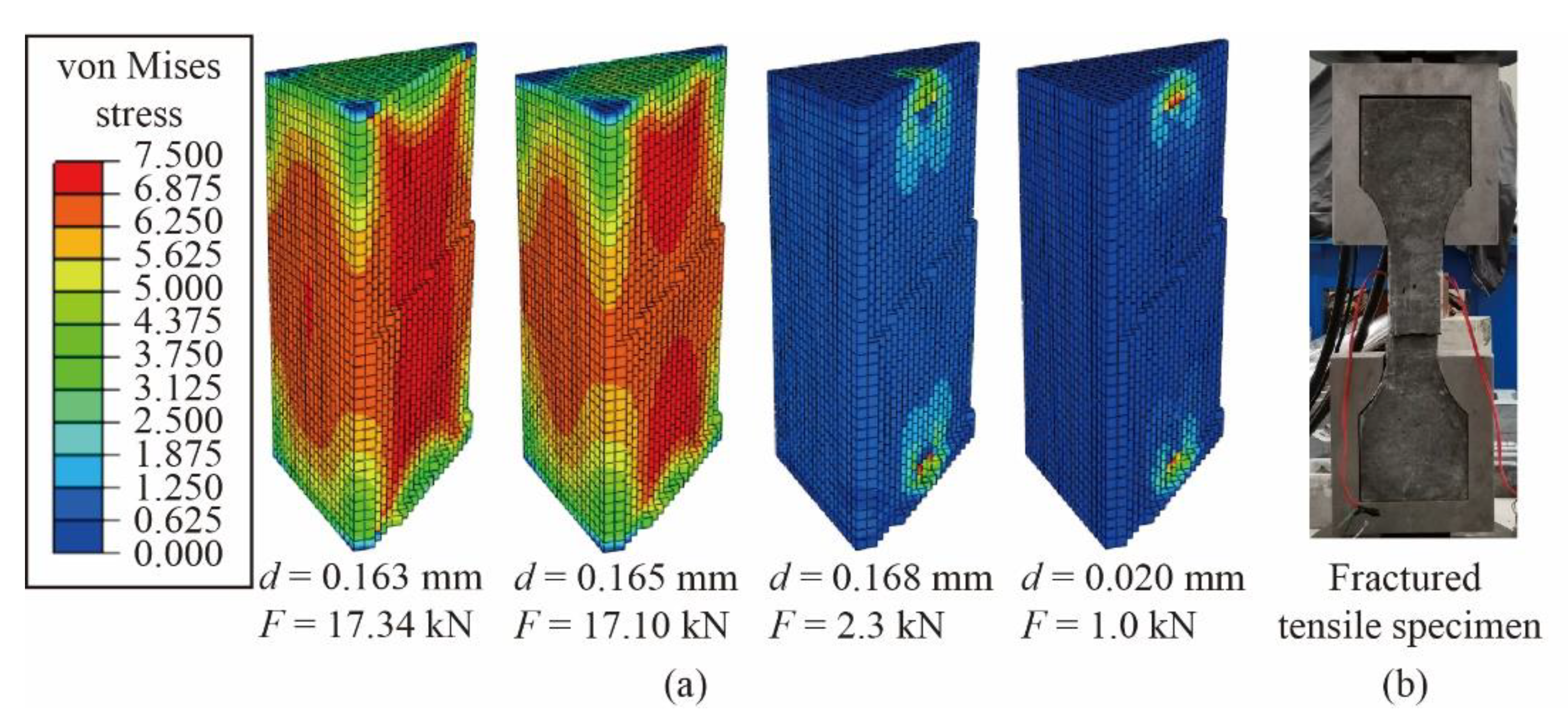
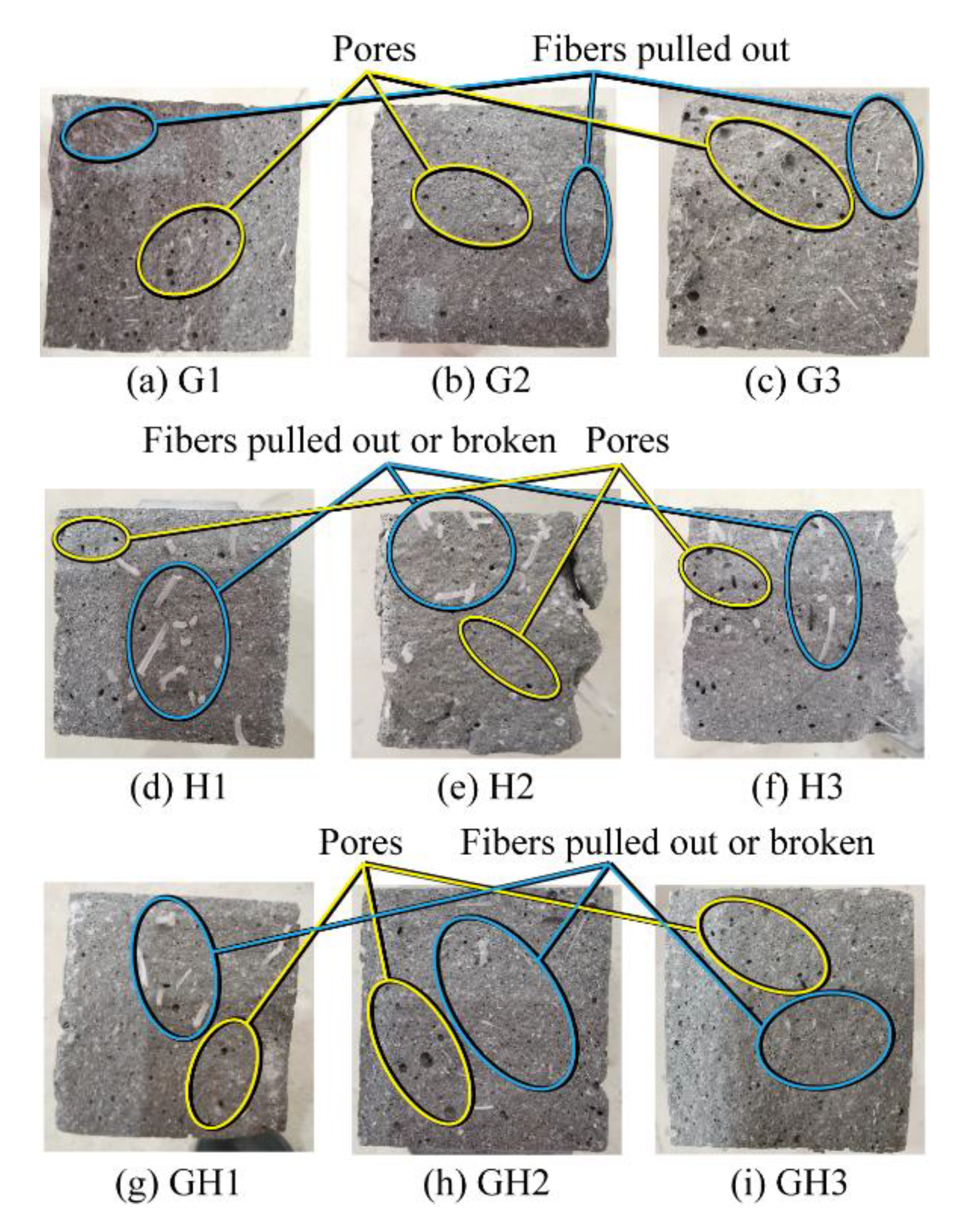
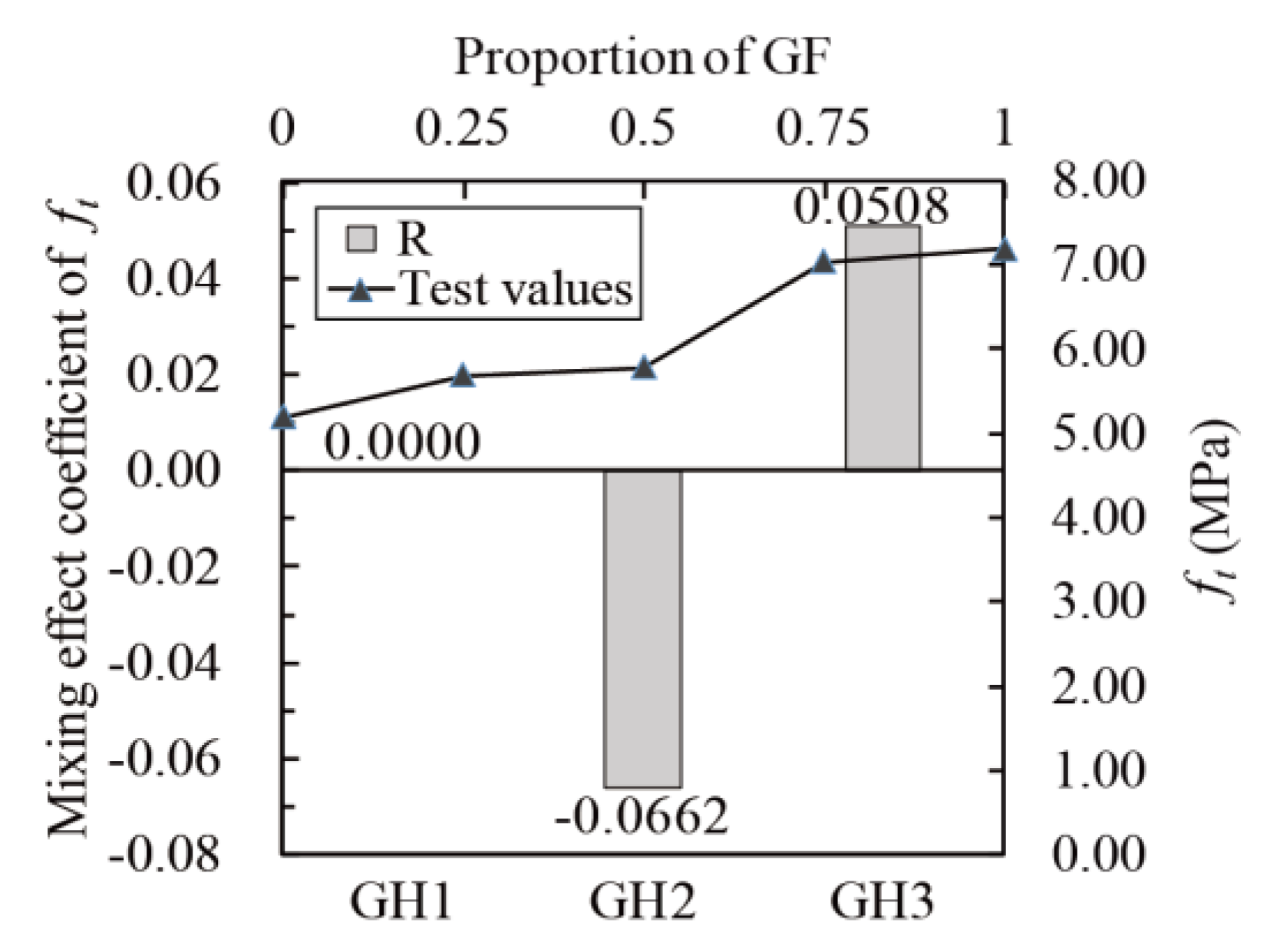

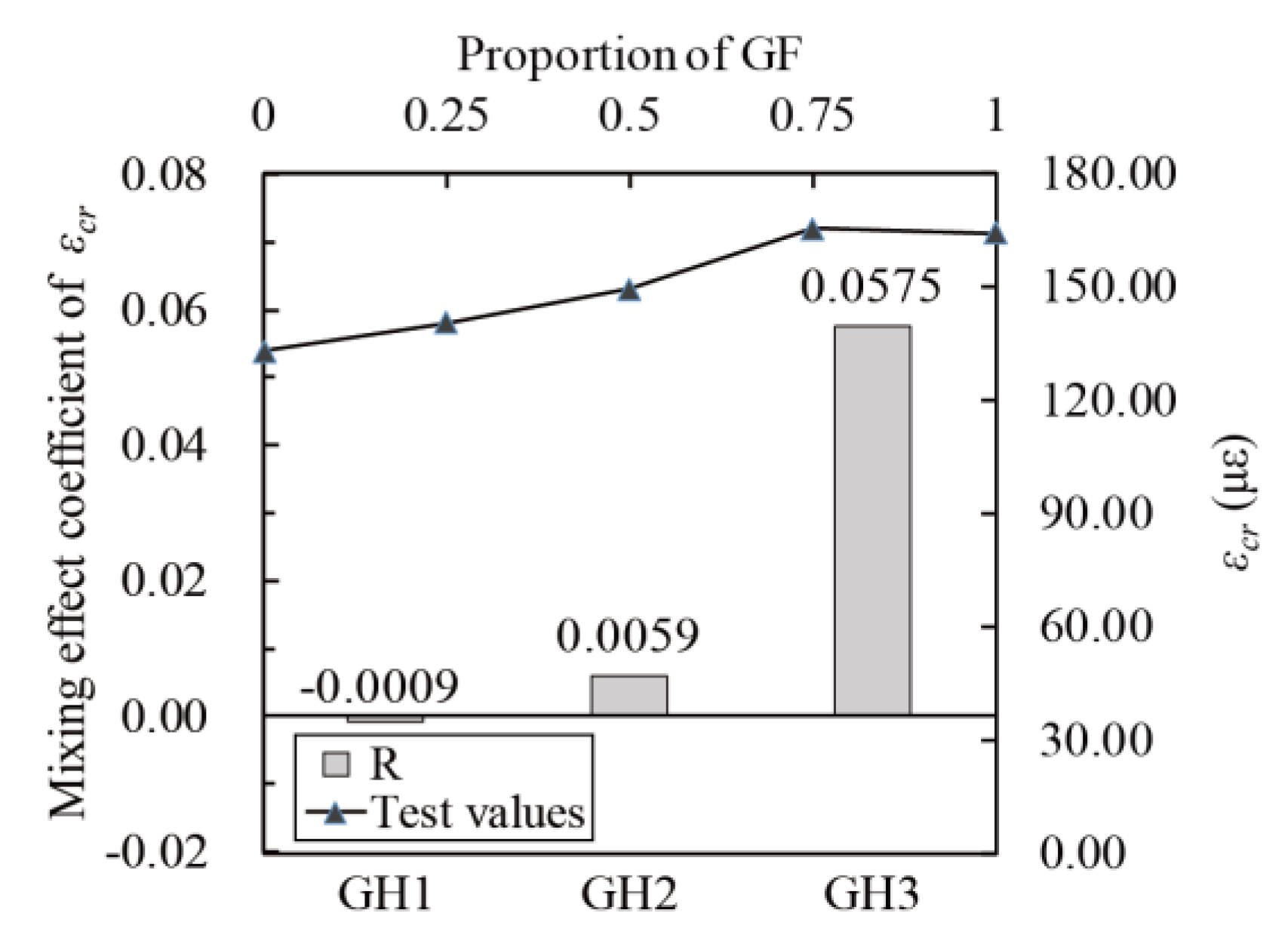
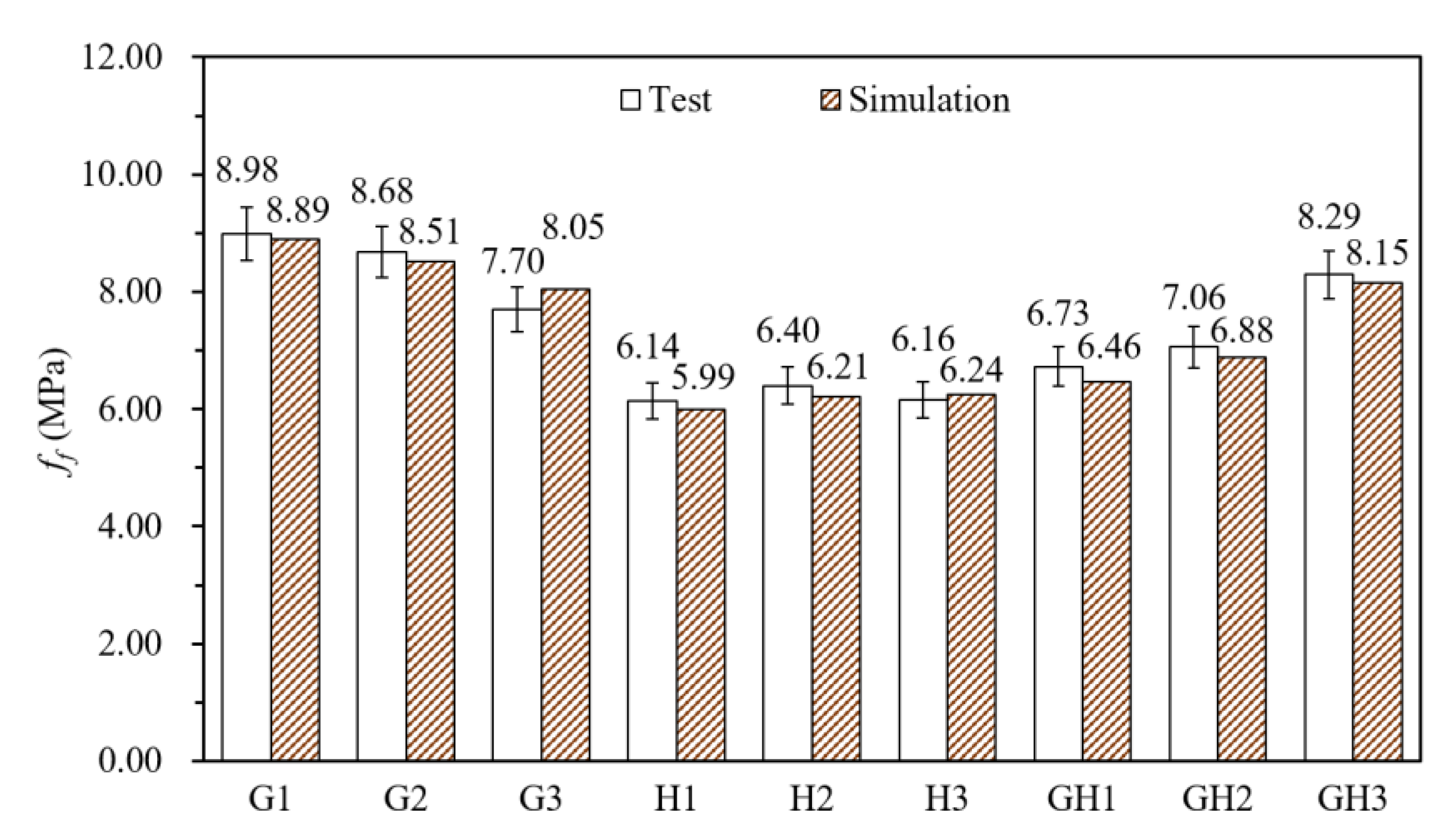
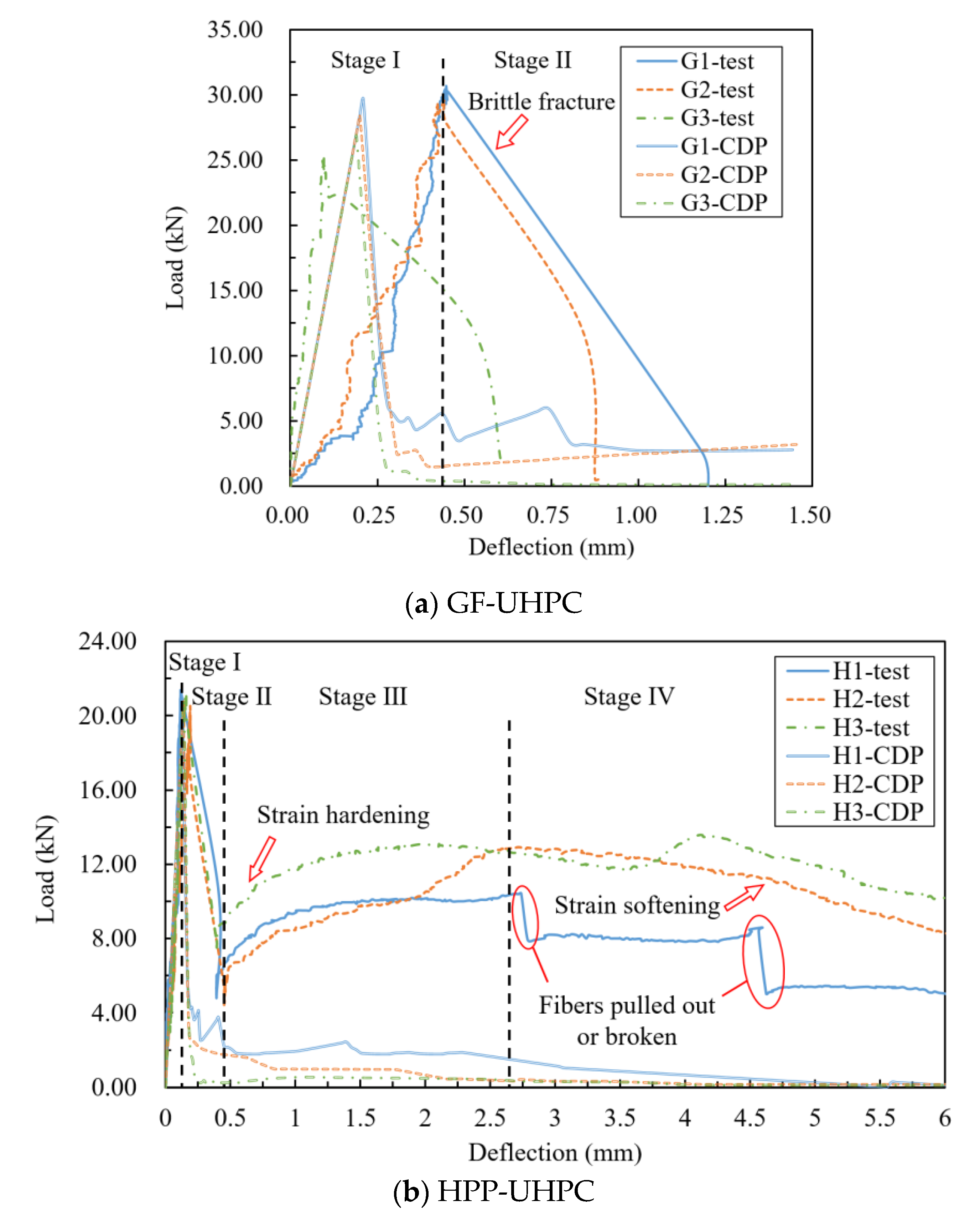
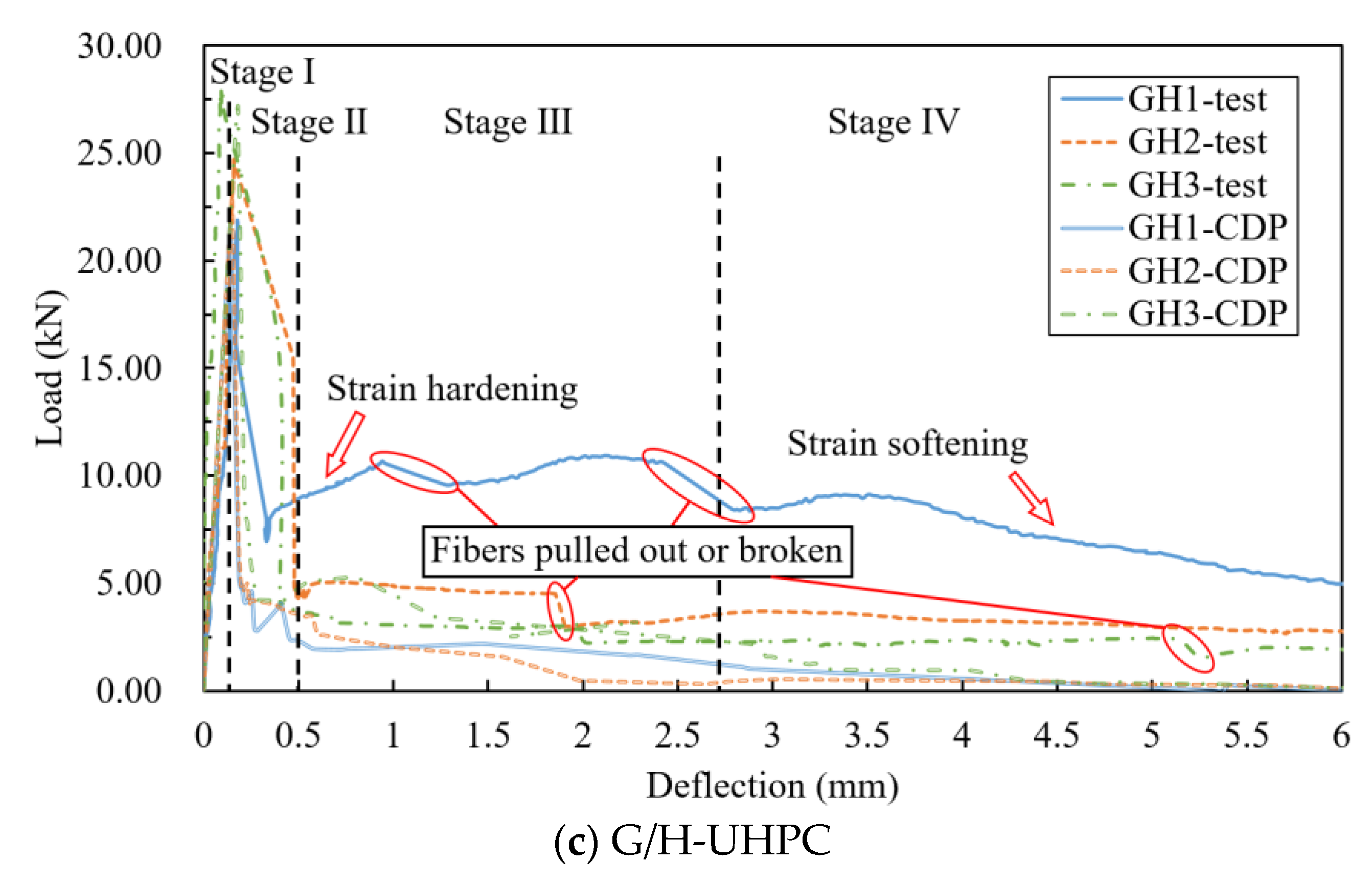
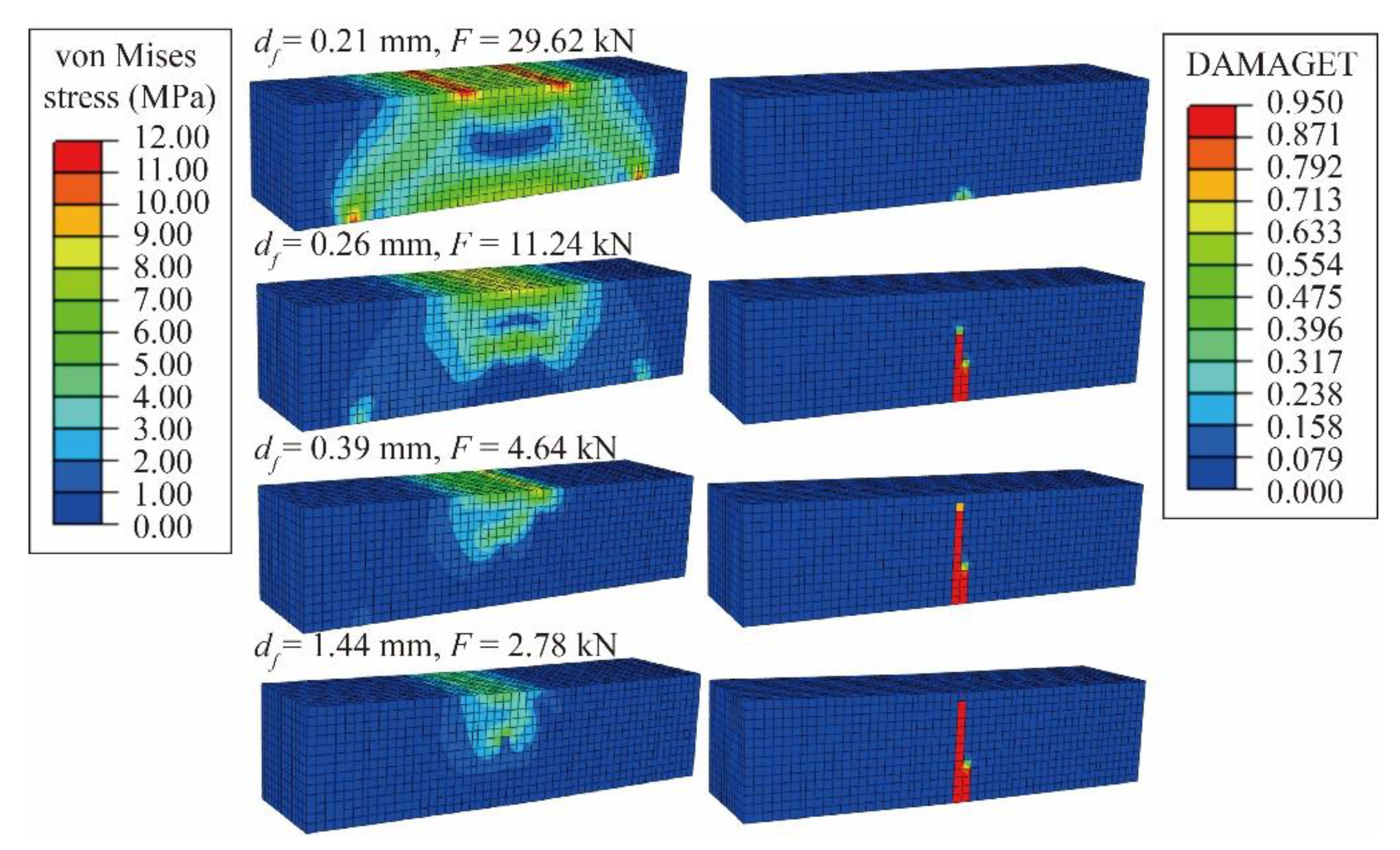


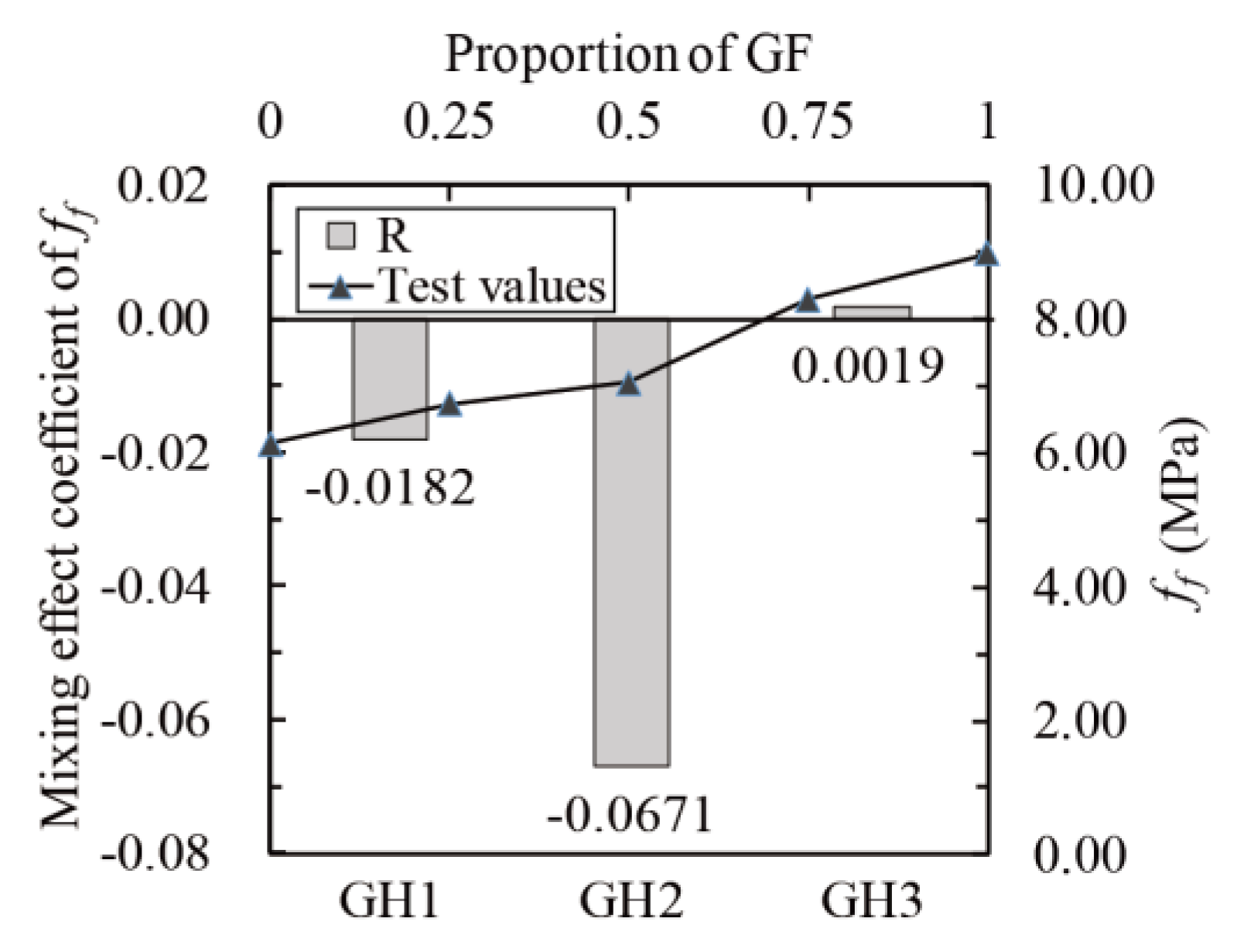
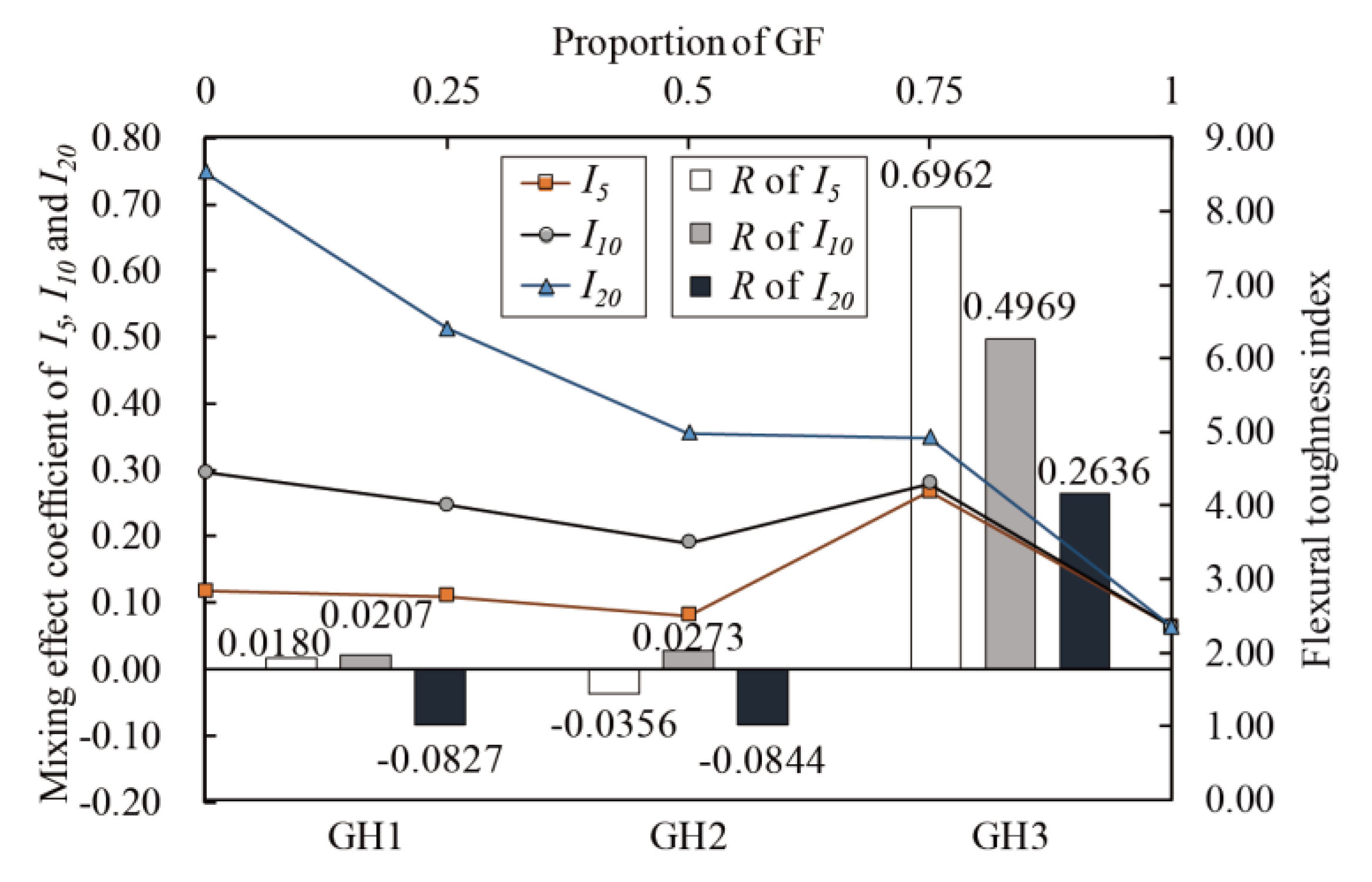
| Types | Length (mm) | Diameter (mm) | Tensile Strength (MPa) | Elastic Modulus (MPa) | Density (kg/m3) |
|---|---|---|---|---|---|
| GF | 6 | 0.015 | 1500 | 71,000 | 2540 |
| HPP | 30 | 0.8–1.5 | 500 | 5000 | 910 |
| Cement | Silica Fume | Quartz Powder | Superplasticizer | Water | Quartz Sand I | Quartz Sand II |
|---|---|---|---|---|---|---|
| 750 | 90 | 263 | 12 | 191 | 306 | 714 |
| Composition | CaO | SiO2 | Fe2O3 | Al2O3 | SO3 | K2O | Na2O | LOI |
|---|---|---|---|---|---|---|---|---|
| Cement | 67.87 | 20.25 | 4.01 | 2.76 | 2.61 | 0.49 | 0.21 | 1.80 |
| Silica fume | 0.25 | 98.00 | 0.10 | 0.20 | 0.52 | 0.25 | 0.20 | 0.48 |
| Quartz powder | 0.31 | 97.40 | 0.30 | 0.31 | 0.65 | 0.37 | 0.26 | 0.40 |
| Quartz sand | 0.25 | 91.78 | 0.88 | 4.34 | 0.02 | 2.06 | 0.22 | 0.45 |
| Types | G1 | G2 | G3 | H1 | H2 | H3 | GH1 | GH2 | GH3 |
|---|---|---|---|---|---|---|---|---|---|
| GF | 1 | 1.5 | 2 | 0 | 0 | 0 | 0.25 | 0.5 | 0.75 |
| HPP | 0 | 0 | 0 | 1 | 1.5 | 2 | 0.75 | 0.5 | 0.25 |
| Name | Axial Compression Test | Axial Tensile Test | Four-Point Bending Test | ||||||
|---|---|---|---|---|---|---|---|---|---|
| fcu (MPa) | ft (MPa) | E (MPa) | εcr (με) | fcr (MPa) | ff (MPa) | I5 | I10 | I20 | |
| G1 | 115.1 | 7.19 | 4.45 × 104 | 164.15 | 7.01 | 8.98 | 2.35 | 2.35 | 2.35 |
| G2 | 114.1 | 7.41 | 4.42 × 104 | 166.81 | 6.69 | 8.68 | 2.32 | 2.32 | 2.32 |
| G3 | 131.7 | 7.51 | 4.58 × 104 | 180.41 | 6.77 | 7.70 | 2.67 | 2.67 | 2.67 |
| H1 | 101.2 | 5.19 | 3.74 × 104 | 132.79 | 5.77 | 6.14 | 2.84 | 4.45 | 8.53 |
| H2 | 95.1 | 5.59 | 4.09 × 104 | 140.72 | 5.50 | 6.08 | 2.81 | 4.76 | 9.25 |
| H3 | 108.2 | 5.81 | 4.43 × 104 | 138.52 | 5.63 | 6.16 | 3.41 | 5.30 | 10.35 |
| GH1 | 101.8 | 5.69 | 4.22 × 104 | 140.50 | 6.06 | 6.73 | 2.76 | 4.0 | 6.41 |
| GH2 | 100.6 | 5.78 | 4.09 × 104 | 149.35 | 6.24 | 7.06 | 2.50 | 3.49 | 4.98 |
| GH3 | 102.3 | 7.03 | 4.37 × 104 | 165.30 | 6.95 | 8.29 | 4.19 | 4.30 | 4.92 |
| Group | fcu (MPa) | fc (MPa) | εc0 | E (MPa) | A |
|---|---|---|---|---|---|
| G1 | 115.05 | 102.39 | 0.0031496 | 39,419.11 | 1.21 |
| G2 | 114.14 | 101.58 | 0.0031442 | 39,318.17 | 1.22 |
| G3 | 131.65 | 117.17 | 0.0032490 | 41,087.27 | 1.14 |
| H1 | 101.15 | 90.02 | 0.0030664 | 37,748.80 | 1.29 |
| H2 | 94.97 | 84.52 | 0.0030294 | 36,906.50 | 1.32 |
| H3 | 108.24 | 96.33 | 0.0031089 | 38,636.40 | 1.25 |
| GH1 | 101.78 | 90.58 | 0.0030702 | 37,830.93 | 1.28 |
| GH2 | 100.60 | 89.53 | 0.0030631 | 37,676.56 | 1.29 |
| GH3 | 102.34 | 91.08 | 0.0030736 | 37,903.38 | 1.28 |
Publisher’s Note: MDPI stays neutral with regard to jurisdictional claims in published maps and institutional affiliations. |
© 2021 by the authors. Licensee MDPI, Basel, Switzerland. This article is an open access article distributed under the terms and conditions of the Creative Commons Attribution (CC BY) license (https://creativecommons.org/licenses/by/4.0/).
Share and Cite
He, J.; Chen, W.; Zhang, B.; Yu, J.; Liu, H. The Mechanical Properties and Damage Evolution of UHPC Reinforced with Glass Fibers and High-Performance Polypropylene Fibers. Materials 2021, 14, 2455. https://doi.org/10.3390/ma14092455
He J, Chen W, Zhang B, Yu J, Liu H. The Mechanical Properties and Damage Evolution of UHPC Reinforced with Glass Fibers and High-Performance Polypropylene Fibers. Materials. 2021; 14(9):2455. https://doi.org/10.3390/ma14092455
Chicago/Turabian StyleHe, Jiayuan, Weizhen Chen, Boshan Zhang, Jiangjiang Yu, and Hang Liu. 2021. "The Mechanical Properties and Damage Evolution of UHPC Reinforced with Glass Fibers and High-Performance Polypropylene Fibers" Materials 14, no. 9: 2455. https://doi.org/10.3390/ma14092455
APA StyleHe, J., Chen, W., Zhang, B., Yu, J., & Liu, H. (2021). The Mechanical Properties and Damage Evolution of UHPC Reinforced with Glass Fibers and High-Performance Polypropylene Fibers. Materials, 14(9), 2455. https://doi.org/10.3390/ma14092455






